
HoofHearted
-
Posts
993 -
Joined
-
Last visited
Content Type
Gallery
Profiles
Forums
Events
Posts posted by HoofHearted
-
-
24 minutes ago, Coffeesforclosers said:
You gotta speak English to the uninitiated, my friend.
They run a ton of Cover 1 (Man Free) and Cover 3.
-
 1
1
-
-
5 hours ago, EmotionallyUnstable said:
How are you categorizing the difference between mid and inside zone? Point of attack/aim point for the rb? DL read? Defensive front?Blocking scheme and point of attack.
-
Gotta have answers for MoF Closed coverages. Eagles live in them.
-
Only way to defend this is to get into a Bear Front or, if we want to stay in our 4 down, condense down to fill both A and B gaps with DL. They need to be in 4 point stances and on the snap drive their shade shoulder into the thigh of the OL in front of them and run their feet as hard as they can. This is the only way to create a stalemate at the LoS. Essentially cut the OL and create a pile of human mass at the LoS to the point where the ball has to bounce.
-
 1
1
-
-
52 minutes ago, hondo in seattle said:
When someone starts proclaiming that they have "The Truth," I usually expect a disappointing case of hubris. But HH has done his homework (thank you!).
But let me ask something... I've heard Orlovsky and others say that the Bills under Dorsey mostly just used two different run concepts. Is there some core of truth to this?
In total we've run 21 different run concepts. We've majored in 5 of them. Here's the data below for each of those concepts.
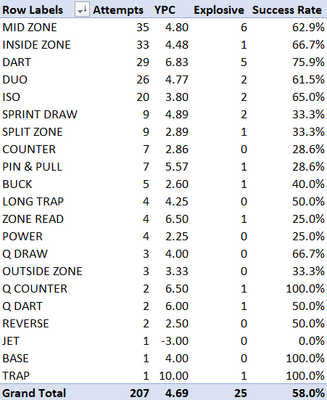
-
 1
1
-
-
1 hour ago, HappyDays said:
I've seen you mention this term before. What is a Pirate game? A specific type of stunt?
Yep. Essentially you want to slant one way with two defensive linemen to collapse the pocket to one side and force the QB to step up opposite the side you are slanting to, and then you wrap a guy around so that the QB steps up right into pressure.
-
 1
1
-
-
4 hours ago, 34-78-83 said:
From the stands, on the 81 Yd TD play to Shakir, it appeared to be quite an impressive "baiting" of the Jets defense by Allen. They moved Diggs into the slot and I feel like the Jets thought they had us with a gotcha! It wasn't Sauce in coverage across from Diggs and it sure seemed like they wanted to bait us into a throw over in that direction into their zone, where they'd likely have 2 guys near the throw with a chance to make a play. Instead, post snap, Josh takes an extended look in that direction, then looks at Kincaid quickly (who opened up the seam for Shakir) then right over to Shakir with the strike, and the gotcha! came in our favor. Great manipulation (I thought) by Josh on the play. I wonder also how much prep goes into a play like that between QB and OC or if its just where Josh is in his game right now. Thoughts, @HoofHearted ?
Josh definitely wanted to go to Diggs initially (he had a 1v1 with a linebacker), recognized it was Hole coverage and knew that the backside double Posts would beat the Cover 3 look as Kincaid was running the collector route (inside post to occupy the Safety) and Shakir would have inside leverage on an in-breaking route vs the corner. Just good recognition and a great job going through his progressions - understanding the coverage and what we were doing offensively that would attack that coverage.
Also want to shout out Diggs and Davis on the earlier touchdowns. Neither of them had the sexy stat line, but they both did a lot of the dirty work. Diggs picked Mosley on the Cook touchdown in order to allow Cook to be wide open, and Davis sold the hell out of a crack block on the flat defender on the touchdown to Johnson completely eliminating him from the play and then hustled down field to shove and shield the corner who was covering him vertical so that he couldn't make a play on it either. HUGE play that will go completely unnoticed by the public.
-
 2
2
-
 3
3
-
-
13:37 mark of the A22 film we line up in a Tite front and confused the Jets protection by doing so. They went half-slide to the field which gave Bernard a 1v1 against their RB in protection. The back wasn't disciplined enough in his rules "scan inside out" and immediately worked out to our walked up linebacker outside (Dodson) and Bernard was unblocked leading to the sack.
At the 22:22 mark we line up in the same Tite front but this time with 5 DL - the Jets set their half slide protection to the boundary this time anticipating the same blitz - but instead we run a Pirate game with Rousseau who ends up drawing the 1v1 with the RB as he scan protects across and allows Bernard to add in to the rush to get the sack.
At the 36:28 mark we show double A gap pressure to an empty set (we've seen this before). What caught my attention was our use of personnel. Instead of using backers to mug the A gaps we used our defensive ends and had our backers coming off the edge. This caught the eye of the Jets as they worked a full slide to the field in order to account for the double A gap pressure which made Wilson responsible for the free rusher. Poyer took a bad angle (didn't aim upfield shoulder of the QB) and he was able to escape by spinning out of the pressure, but it was a really intelligent use of personnel to ensure we got our best athlete unblocked on the rush.
There were some simulated pressures as well throughout the game where we forced the Jets to set protection one way only to drop those players out and bring overloaded pressures from the opposite side of the field. I really wanted to bring these specifically to light because McDermott gets a ton of flak for his pressure packages when he puts on a master class of dialing up pressures to attack protections and guarantee 1v1 match-ups with RBs (and more often than not getting 2v1 on a RB) in order to win in these scenarios.
-
 1
1
-
-
6 minutes ago, Buffalo Bills Fan said:
Brady didn’t use RPOs the way that Dorsey liked to. Instead, he married a pass to a quarterback run. I liked that adjustment because it makes things more clear and easier for the quarterback.
Not sure what he's referring to here, but I assume it was the QB Draw that was dead to rights that Josh tried to pull up on and look for a pass option. That's not an RPO, just Josh trying to make a play. We ran a couple RPOs and they were the same as what we've been doing. Like I've said - we ran the same concepts as we have all year - we just dressed them up to take advantage of some match-ups better than we have in the past.
-
 1
1
-
-
2 hours ago, HappyDays said:
Kurt Warner posted this video yesterday:
He has been saying that Dorsey was not the problem and didn't agree with him being fired. So in this video he tries to show how our offense against the Jets was exactly the same which to him is proof that Dorsey was not the problem.
But interestingly he kind of accidentally shows that Brady's offense is not the same. Same concepts but dressed up more, like you said. It's almost bizarre how Kurt Warner glosses over some of that stuff in this video. On one play he fails to point out that a Diggs motion against the Jets made Kincaid a lot more wide open than he was in a similar play against the Broncos. He compares a true mesh against the Broncos to a fake mesh against the Jets but to me those concepts created entirely different passing windows to Cook in the example plays he shows.
If you get a chance to watch this 10 minute video I'd be interested to hear your thoughts.
I mean he’s not wrong. It’s the same scheme, but we knew it was going to be the same scheme. Dorsey wasn’t fired because of the scheme - he was fired because he was told to fix the execution issues and they never got fixed. If you can’t get players to respond to coaching then you lose your job - it is what it is.
-
 1
1
-
 3
3
-
-
6 minutes ago, Coach Tuesday said:
You refer to the motion as “window dressing” but from what I could tell, they were actually using the information they got from the defense as a result of it, which seemed to be an issue under Dorsey.That wasn’t meant to infer that it didn’t have purpose. We used CoS motions to great effect to get favorable matchups or pull backers out of the box. It also caused confusion multiple times as they didn’t know whether to bump their nickel into the box and bump the backers or whether to carry the nickel across and flip the backers (this is ultimately what they started doing). We used motions out of the backfield to identify coverages as well as to widen backers and open up pass lanes in the middle of the field.
My point was the concepts didn’t change from what Dorsey was running, we just dressed them up to make them more effective.
EDIT: And to be fair to Dorsey when he did use motions he did it intelligently and with purpose. He just didn’t do it often enough imo.
-
 2
2
-
 3
3
-
-
7 hours ago, HappyDays said:
Cover1's latest video claims that Brady's sequencing of route progressions is more fluid than Dorsey's. As in when Josh goes from progression 1 to 2 to 3, the route he looks at next is flashing into his vision at the exact right time, whereas with Dorsey it was more all over the place which led to timing issues. Do you agree with this having watched the Jets film?
100% agree that motions made all the difference in this one. I think Josh is one of the best QBs in the league at properly identifying leverage in coverage players and choosing his throw accordingly. If he sees your hips turned even an inch in the wrong direction, you've already lost. I felt that motions in this game gave him clear leverage identifiers that he took full advantage of. Good example of what I mean on this play:
I may of course just be talking out of my ass here 😁
I’ve only made it through the first half but so far every concept I saw we’ve run before so not sure what he’s referring to.
-
1 hour ago, Matt_In_NH said:
I think this is overblown. Most of the complaints are shotgun run at the half yard line which they have done and failed twice. I stand by my opinion that is a bad call in that situation It because they can’t get the half yard but because if it is blown up you stand to lose much more.
If you go through the thread we actually have a higher SR at the 1 out of Gun albeit small sample sizes. Likewise the percentage of plays resulting in a loss or no gain is higher from under center than out of gun.
Now that doesn’t mean I’m suggesting always run from gun at the one (as many have pointed out the QB sneak has the highest conversion rate of any play in those scenarios), but there is a lot of misconception about running from gun.
-
 1
1
-
-
Just now getting to the Jets film. Watched the first half and there's some really cool things McDermott did with personnel and pressure packages. I'll post diagrams and more detail tomorrow at some point. Offense through the first half didn't look much different as far as scheme is concerned from what we've been doing. Only real difference was the window dressing with the motions. Used change of strength motions quite a bit to get favorable matchups - targeted the linebackers in particular which was really nice to see.
-
 4
4
-
-
1 hour ago, DapperCam said:
Two things I would be curious about:
- What is the tackle for loss or no gain rate for shotgun runs vs under center. My impression is that under center runs have lower ceiling and higher floor (less likely to result in a negative play).
- What is the play action success rate out of shotgun vs under center. If play action is a lot more successful under center, then it is worth it to run the marginally less effective under center running plays.Under center is a 1% higher rate for loss or no gain. Unfortunately I don't have any data on your second question as I was just charting run schemes.
-
 2
2
-
-
7 hours ago, Ray Stonada said:
I love that we’re running more 4-3.
Game has shifted and this is a good call.
We only went big because they were going big. I don't expect that to be a staple going forward.
-
 1
1
-
-
45 minutes ago, GoBills808 said:
That could also be accomplished by morning him out wide tho right
Is this a specific look they're trying to get on tape or something? Or is that motion across formation just standard
Against man it just pulls whoever is covering him. Against zone it would pull a box defender (OLB since it’s a change of pass strength motion) out of the box.
20 minutes ago, eme123 said:Offenses have a clear advantage in the pass game. The more you’re running the more you’re losing. The fantasy nuts just refuse to believe it.
And the data nuts will have you believe you should throw 100% of the time. There’s a sweet spot in there somewhere, but it’s going to vary based on opponent and how they play.
-
 3
3
-
-
1 hour ago, Nephilim17 said:
HH, thanks for the deep dive here. Can you give a rough idea of how many times a game you'd like to run the ball and perhaps numbers just for Cook? Do you believe he's too small to be a feature back?
Many people here think with JA throwing you don't need to run a lot and it's a "waste" of snaps. Do you agree?
Thanks.
I think you’d be doing yourself a disservice if you put an arbitrary number to rushing attempts. There’s just so many variable involved. The easy answer is enough times to not allow your opponent to pin their ears back and penetrate every snap, but that threshold varies based on the team you play. I do think you ideally want to get Cook 16-18 touches a game in any capacity you can though.
1 hour ago, GoBills808 said:ty 🤙
so Torrence just wasn't able to get to the second level but the numbers were right
one more question specific to this play, what does Diggs playside motion accomplish here?
Torrence looks kind of unsure of himself in zone blocks vs Jets
It pulls a defender out of the box.
-
 1
1
-
 1
1
-
-
2 hours ago, WideNine said:
Thanks for this breakdown.
I have thought that the Bills usually do a pretty good job running the ball and mixing it up. The issues have been how they have oddly abandoned it for long stretches when they are winning up front and gashing opposing teams.There were times we got stuffed or TFL, but seemed we ran straight into number disadvantages and never checked out of those plays.
Suspect those had more to do with the lack of effective in-game offensive staff communication that McD indicated had improved this last game.
Regarding runs from under center, as you mentioned I would like to see more near the goal line before drawing any conclusions, but think there is also an advantage of Allen potentially sneaking on those too that you lose from shotgun.
Allen's good use of play action from under center has been more my contention for leaning into it.He hides the ball better, and tends to hit the back foot on his drop and be decisive with getting the ball out on schedule...
They don't have to feature it, but mixing in a bit more in I think would be beneficial.
Excited to see how Brady uses our run playbook as I already really like his use of motion creating space for getting the running backs more involved in the passing game.
For what it’s worth I don’t recall ever seeing us run into a numbers disadvantage while going through the film. Again, I think this has more to do with people not understanding what is considered “the box” when we’re in condensed sets.
-
9 hours ago, EmotionallyUnstable said:
@HoofHearted Any thoughts on why we don’t see any pistol from this team?
A lot of the benefits of being under center and in gun, but rarely do I recall seeing us use it.
Pistol takes a ton of time to get right because of how different it is. It messes with timings, footwork, and aiming points - all of these would have to be taught differently than Gun and Under Center run concepts.
Look up Chris Ault if you want to learn more about it. When he was at Nevada they spent an entire spring ball developing their pistol offense and it took a ton of time to get all of the kinks worked out.
-
17 hours ago, Old Coot said:
Excellent analysis.
Over the past several games the RB consistently gets to the 2d level before being hit. This suggests that the OL is opening holes for the RB, something that the OL hasn't been able to do consistently in the past.
Do you have any insight as to why the OL is able to open holes? Is it scheme? OL jelling? Something else?
The OL has been playing really well this year overall in the run game. There is some scheme stuff that we’re doing with our zone concepts (folding Mitch fairly often on inside and mid zone) that I may do a post on in the X’s and O’s Thread at some point.
-
 1
1
-
-
14 hours ago, Beck Water said:
OK I had to sit back and digest a bit.
I have a couple of questions. You mention top 5 run concepts, but then 16 other run concepts (21 total).
1) just to help me contextualize, do you know or can you estimate how frequent the "top 5" are vs the others?
2) again to help me contextualize, any estimate about what success rate the other concepts have, again, aggregate?
3) I think this is an important ask to some here - any different success ratio in the red zone? I think there has been a lot of angst on this board about shotgun run play calls in a 'goal to go' situation. Since the defense is condensed in this situation, it seems to me the success could be affected?
I hope these are straightforward asks, I don't mean to be a PITA looking at a massive data endeavor and saying "please Sir can I have some more?" 🥣
Last Q just curious, what video is this which ripped our Inside Zone and Duo?
Thanks!
OVERALL DATA SET
OVERALL DATA SET (Center/Gun Split)
REDZONE SR (20 & In)
ONE YARD LINE SR
-
 2
2
-
-
17 hours ago, EmotionallyUnstable said:
Great stuff.
It’s been debunked that the bills can’t run. The issue is more so that they don’t run, or haven’t when they possibly should have.
Two other splits of interest:
How has success rate changed based on RB? Cook played roughly half the snaps last week. Is this guy really that bad in pass pro or are they just trying to save his legs a bit? He can be electric with the ball in his hands but why the handcuff? Murray is no slouch and Ty Johnson came out of no where, but I think it’s fair to ask more of a 2nd round pick who we all thought would be a work horse.
How has personnel effected success rate in the ground game? Are we significantly better out of 11, 12, 21 or even with David Edwards as the 6th OL?
Thanks for the data and explaination!
I didn't track personnel as I went through this, but I'm sure there are some people on here who have access to advanced stats who can get that split. As far as SR by player:
Allen - 71.4%
Harris -66.7%
Cook - 57.5%
Murray - 56.9%
The rotation I'm sure is to keep Cook fresh.
-
1 minute ago, GoBills808 said:
🤙🤙That would be awesome

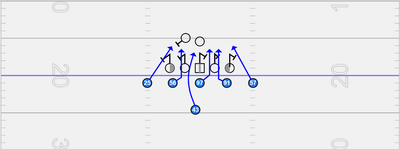
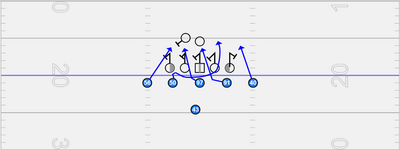
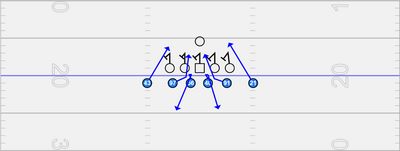
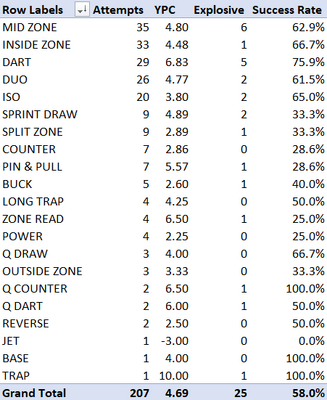
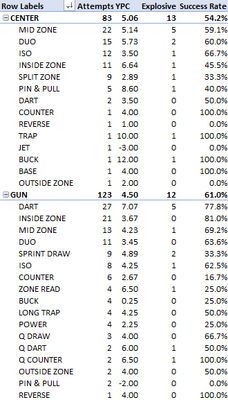
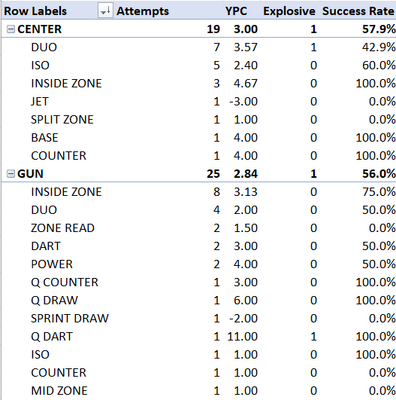
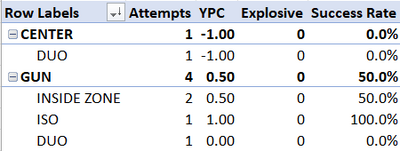
Week 12: Buffalo Bills vs Philadelphia Eagles
in The Stadium Wall
Posted
Curl/Arrows up and down the field just like against the Bucs!